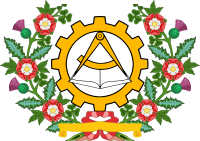Emblem of the Gymnasium State
| Emblem of the Gymnasium State | |
|---|---|
 | |
| Details | |
| Armiger | Samuel McKittrick |
| Adopted | 4 September 2017 |
| Escutcheon | Open book and golden compass on a golden cogwheel |
| Supporters | A wreath of Tudor roses, thistles and shamrocks |
| Use | On the national flag; on websites or logos related to government of the Gymnasium State |
The national emblem is one of national symbols of the Gymnasium State. It has been in use since 4 September 2017, which makes it the oldest continuously used national symbol of the micronation, however it only was legally specified on 19 April 2019 with the National Symbols Law. Although it is often referred to as a coat of arms, heraldry considers it an emblem, because it does not follow the traditional heraldric rules. On top of the official version of the emblem, used for instance on the national flag, other variants exist that are sometimes used, but lack official status.
History

At the time of the declaration of independence there were no proposals for the national coat of arms or the national emblem for the Socialist State of Gymnasium. During the first session of the Council on 4 September 2017 a flag for an alternate history communist Great Britain[1] by a Northern Irish vexillologist Samuel McKittrick was discovered and adopted as the national flag. This flag featured what became the national emblem, including hammer and sickle above itself. On 6 September it was proposed to remove the hammer and sickle from the flag and therefore from the emblem as well as part of a larger flag reform, but this was rejected. The emblem was never officially adopted by the Socialist State.
With the establishment of the Second Republic new national symbols had to be chosen for the reformed micronation. To keep continuity with the Socialist State it was decided that the new regime will keep using the old emblem, which then became the official emblem of the Gymnasium State on 29 December 2017. The status of the official emblem was solidified on 19 April 2019 by the National Symbols Law, which also confirmed Samuel McKittrick as the author of the design, all efforts to contact McKittrick to reach a bilateral agreement however failed. In August 2020 the government abandoned the original raster emblem and published a vector version, but many old documents and items still use the original design.
Description
The emblem of the Gymnasium State incorporates elements of both socialist and British heraldry. This is despite the fact that the Gymnasium State is neither a socialist state nor in any way influenced by the British culture and is caused by the original purpose of the design as a proposal for a communist Britain.[1] The National Symbols Law describes the emblem as follows:
The national emblem of the Gymnasium State consists of an orange (gold) cogwheel with an orange (gold) compass opened above a white open book. The cogwheel is lined by a wreath of roses, thistles and shamrocks tied from the bottom with a golden ribbon.
— National Symbols Law of the Gymnasium State, Article 2, Section 1
The first annex of the law also features the design of the emblem, including graphical errors included in the design at the time of adoption.
The central design of the emblem is apparently one of symbols of the British communists[1] while the wreath features heraldic badges of the British countries. The Gymnasium State however decided to drop the original British symbolism and instead assigned the elements with its own symbolism in the section 3 of the Article 2 of the National Symbols Law. The compass and book were attributed as symbols of intelligence, the cogwheel is said to represent progress and the wreath as a whole was ascribed to represent life.
Variants
Although the laws of Gymnasium State define only one official design of the emblem, two unofficial variants are also sometimes used. A lesser emblem, which only includes the central combination of the cogwheel, compass and book, used to enjoy a de facto co-official status alongside the original version, however it was not included in the National Symbols Law. The lesser emblem is still often used as part of military symbols of the micronation. The second version of the emblem, featuring a Roman wreath of olive and oak branches instead the official wreath, is used on Gymnasian ID cards. This is because at the time of creation of the first set of the ID cards the resolution of the official emblem was too small to be used on the cards and no better replacement was found. While this design is also not considered an official version of the emblem, it is still used on the ID cards to this day.
-
Lesser emblem of the Gymnasium State
-
Variant emblem with an alternate wreath used on ID cards
Notes and references
- ↑ 1.0 1.1 1.2 MCKITTRICK, Samuel: Communist British Isles (Alternative History). Sam's Ramblings. Retrieved 26 October 2022


